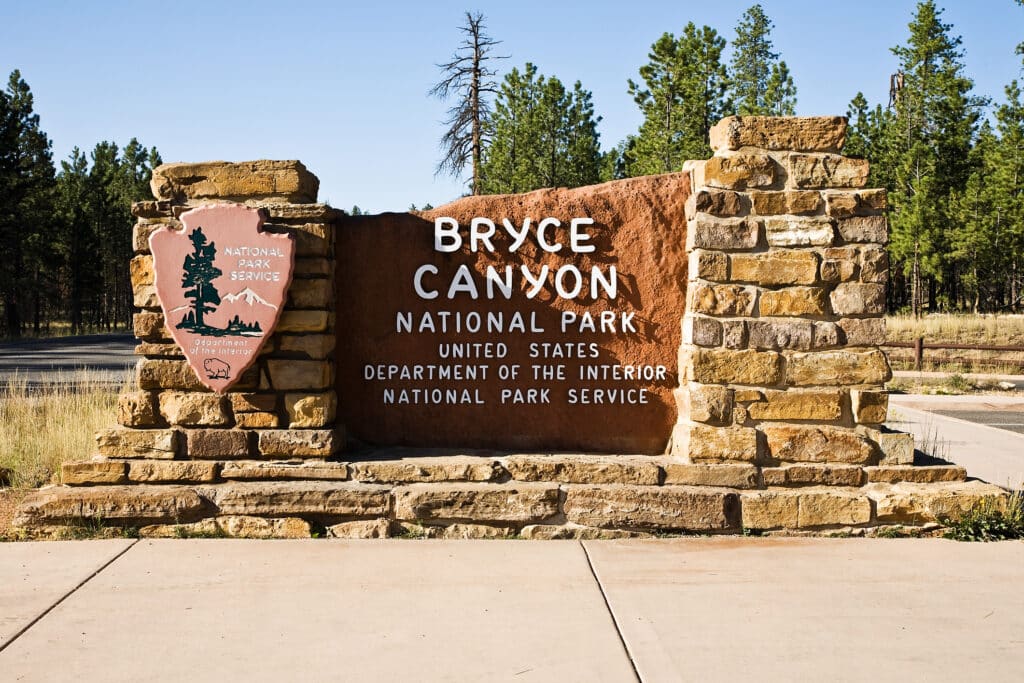
Bryce Canyon National Park is open year-round, 24 hours a day (extreme weather permitting). The park’s entrance fee is $35 per private vehicle, granting 7-day access for the driver and all passengers. Motorcyclists pay $30 for a 7-day pass, and individuals on foot or bicycle pay $20 per person (7-day). Children 15 and under enter free. There’s also a $70 Bryce Canyon Annual Pass for those who visit often. The interagency America the Beautiful Pass is $80 and covers this and other national parks nationwide (U.S. seniors can get a discounted version for $20/year or $80 lifetime, while military members, veterans, and 4th-grade students are eligible for free passes). The park does not accept cash at entry, so have a card ready. In peak season (typically mid-April through mid-October), the entrance fee includes use of a free shuttle bus that stops at major viewpoints – a great way to avoid parking hassles.
Operating hours vary by facility. The park gates never close, but the Visitor Center is generally open daily from 8:00 am, with longer hours in summer (usually until 8:00 pm) and shorter hours in winter (closing by 4:30 pm). The Visitor Center and fee booths are closed on Thanksgiving and Christmas Day, though the park itself remains accessible. Seasonal conditions bring a few limitations: during winter months, heavy snowfall can temporarily shut down roads (the scenic drive beyond mile 3 is sometimes closed until plows clear it). In the dry summer fire season, the park may enact fire restrictions – for example, banning campfires in campgrounds – to prevent wildfires. Otherwise, all major sights and trails stay open year-round. We visited on 27 July 2025, and all figures were valid then.
About Bryce Canyon National Park
Bryce Canyon National Park protects a stunning high-elevation landscape in southern Utah, characterized by its otherworldly hoodoos – thousands of red and orange rock spires clustered in horseshoe-shaped amphitheaters.
Is Bryce Canyon really a canyon? Technically, no — it’s a series of natural amphitheater basins carved into the edge of the Paunsaugunt Plateau rather than a single canyon. Over millions of years, water, ice, and gravity have eroded the plateau’s limestone rock into the hoodoos we see today. Ever wondered how those whimsical spires got their shape? The process is driven by freeze-thaw erosion: rainwater seeps into cracks, then freezes overnight and expands, breaking the rock apart bit by bit. At Bryce’s elevation (around 8,000–9,100 feet or 2,440–2,780 m), this freeze-thaw cycle happens up to 200 times a year, so the sculpting of the cliffs is remarkably active. In fact, the plateau’s rim is retreating by a few inches every decade as old hoodoos collapse and new ones form. We stood at the top of the Bryce Amphitheater and realized the landscape is essentially alive, slowly but steadily changing with each season.
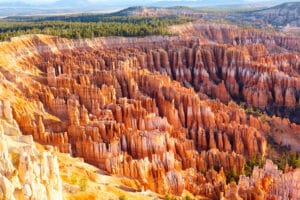
Amphitheater from Inspiration Point at sunrise, Bryce Canyon National Park, Utah, USA
Despite its name, Bryce Canyon is actually a mosaic of diverse ecosystems thanks to the big elevation range. The rim and plateau are topped by spruce-fir and ponderosa pine forests, with lush meadows in between. Down below the cliffs, the environment transitions to juniper and sagebrush lowlands. This mix of habitats means the park supports a rich variety of wildlife. We spotted mule deer and pronghorn grazing in the open meadows, and chipmunks darting between the rocks.
Ravens and hawks often soar above the cliffs, and in total over 200 bird species have been recorded here. Uniquely, Bryce Canyon is the only national park home to the Utah prairie dog, a threatened species. These pint-sized prairie dogs were reintroduced to the park’s valleys in the 1970s after their populations plummeted, and now small colonies thrive under protection (summer visitors might see them popping up from their burrows in the daytime).
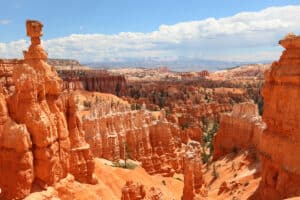
Bryce Canyon National Park landscape
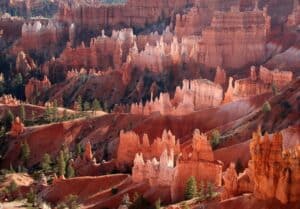
Bryce Canyon national park, Utah, USA
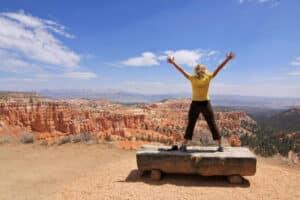
Bryce Canyon national park, Utah, USA
Larger animals like black bears or mountain lions are rare sightings, but coyotes, foxes, and elk occasionally roam the quieter parts of the park. For the best chance to observe wildlife, we found early morning and dusk to be ideal – animals are more active then, and there are fewer people around. (The flip side of Bryce’s 8,000+ ft elevation is that even in July the mornings can be chilly. We kinda underestimated how cold the nights get up here, so we were glad we packed jackets for the pre-dawn chill.)
Bryce Canyon’s human history is relatively recent. The area is named after Ebenezer Bryce, a rancher who homesteaded here in the 1870s (famously quipping that it was “a hell of a place to lose a cow”). By the 1910s, the scenic beauty of Bryce’s rock formations was gaining attention, and in 1923 it was designated a National Monument. Five years later, in 1928, Bryce Canyon became a National Park, set aside to preserve its unique geology and vistas for future generations. Park management today continues that mission with modern science – for instance, rangers conduct controlled burns in the surrounding forests to clear excessive underbrush (mimicking natural fire cycles and reducing the risk of major wildfires). They also actively work to keep Bryce’s night sky dark: in 2019 the park earned certification as an International Dark Sky Park. On clear nights, we could see an astonishing number of stars arching over the hoodoos. The Milky Way was clearly visible, and the park hosts stargazing programs in summer that we highly recommend if you enjoy astronomy. It’s inspiring to see how well the park balances tourism with conservation efforts.
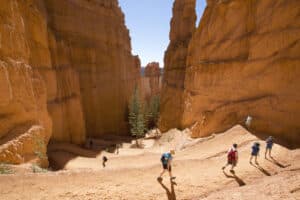
Hikers at Queens Garden trial at Bryce Canyon National Park in Utah
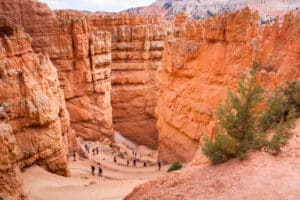
nside Bryce Canyon, at the end of the Navajos Loop trail, a winding serpentine course returns to the Rim Trail
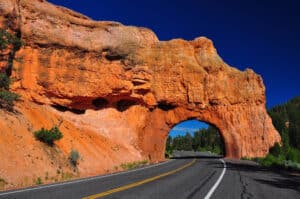
Red Arch road tunnel at bryce canyon
For visitors, Bryce Canyon offers a great mix of scenic drives, hikes, and ranger activities. Most people start at the Bryce Amphitheater area, where several overlooks and trailheads are concentrated. We recommend beginning at Sunrise Point or Sunset Point – they are easy to access and give jaw-dropping first views into the canyon of hoodoos. The two points are also trailheads for the park’s most popular hike, the Queen’s Garden/Navajo Loop.
We hiked this combination loop (about 2.9 miles/4.6 km round-trip) and loved it. The trail drops quickly from the rim, zigzagging down through narrow switchbacks (Wall Street section) and winding past famous formations like Thor’s Hammer. It’s a moderate trail that took us around two hours with plenty of photo stops. Walking among the hoodoos, looking up at those towering orange pinnacles, was an entirely different experience than viewing them from above – one we’re very glad we didn’t skip. (Just wear good shoes and carry water; the climb back up is steep but there are shady rest spots.) After emerging at Sunset Point, we took a leisurely stroll along the Rim Trail to return to our car at Sunrise Point. The Rim Trail between Sunrise and Sunset Points is relatively flat and under a mile, offering constant panoramic views – a perfect cool-down walk after the loop hike.
If you have more time or energy, there are plenty of other trails too. The Rim Trail actually continues further, eventually spanning 11 miles total from Fairyland Point to Bryce Point. We walked smaller sections of it near the amphitheater, but ambitious hikers can do the entire length for nonstop vistas. Another recommended hike is the Fairyland Loop (8 miles/12.9 km round-trip), which starts near Fairyland Point and plunges into a less-visited section of the park with pastel-colored hoodoos. It’s longer and has significant elevation change, so we saved that one for next time. For a true backcountry adventure, the park has the Under-the-Rim Trail (23 miles one-way) and Riggs Spring Loop (8.8 miles) in the southern backcountry – these require planning and an overnight permit, but offer solitude among Bryce’s wilderness. Casual visitors don’t need to tackle those, but it’s neat to know Bryce Canyon has both easy walks and hardcore treks available.
One thing that surprised us was how much we ended up doing in a day. We were gonna spend just the morning at Bryce, but we found ourselves still exploring at sunset! While it’s possible to see a few highlights in 3–4 hours (for example, a quick drive and a short hike), you’ll appreciate the park more if you allocate at least a full day. We spent one full day and felt it was just enough to cover the main viewpoints, a couple of hikes, and even an evening ranger talk. If you love hiking or photography, consider two days so you can catch both sunrise and sunset, do multiple hikes, and maybe join a night astronomy program. Also, start your day early if you can. We began at dawn and had some trails almost to ourselves – by late morning, tour buses and crowds were much more noticeable at the overlooks. In peak summer, the shuttle bus (runs 8:00 am to 6:00 pm in season) is worth using to avoid parking stress in the busy amphitheater area. Overall, Bryce Canyon might not be the largest park, but it’s the kind of place that rewards unhurried exploration.
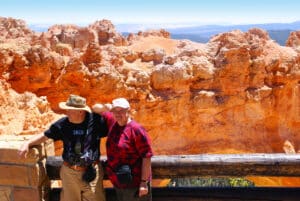
Bryce Canyon
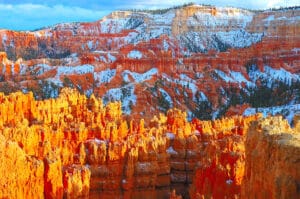
Scenic Highlights, Trails & Dining Options
Beyond the main amphitheater, we found plenty of other sights to explore in and around the park, as well as some satisfying places to eat and relax after our outdoor adventures. Here’s what we experienced:
Scenic Highlights Around the Park
-
Sunrise & Sunset Points: We started our day at Sunrise Point to watch the first light hit the canyon. It was a chilly pre-dawn wake-up, but we had the overlook almost to ourselves and the sight of the hoodoos slowly glowing orange in the morning sun was well worth it. In the evening, Sunset Point was the go-to spot – easily accessible and appropriately named. We joined other visitors to witness the amphitheater bathed in golden light as the sun went down. These points are conveniently close to each other (a short walk apart) and are the best for dawn and dusk views. Getting there early not only gave us a fantastic show but also helped us beat the rush; by mid-morning, these viewpoints were significantly more crowded.
-
Bryce Point & Inspiration Point: Later, we drove to these higher overlooks to take in different perspectives. Bryce Point (at the end of a short spur road) offers one of the grandest panoramas in the park. One of the highlights were the vibrant orange hoodoos stretching out in every direction beneath us. We could even spot hikers like tiny specks on the trails below. Inspiration Point, just north of there, has three levels of observation, each a bit higher up. We climbed to the top tier of Inspiration Point and were rewarded with an incredible overlook of the Bryce Amphitheater’s multicolored cliffs. (Note: the railing at Inspiration Point is minimal and the drop-offs are steep, so we walked carefully here.) Both points gave us a real appreciation for the scale of the canyon’s geology.
-
Scenic Drive to Rainbow Point (and Natural Bridge): In the late morning, we set out on the 18-mile scenic drive that runs to the southern end of the park. We recommend doing this drive when you have a couple of hours free; it’s an out-and-back road with numerous pull-outs. Our first stop was Natural Bridge, an impressive red rock arch spanning a pine-filled ravine. It’s right off the road and makes for a great photo op. Continuing on, we passed several lesser-known overlooks (Agua Canyon, Ponderosa Canyon) and eventually reached Rainbow Point, the road’s terminus at 9,115 feet elevation. From the Rainbow Point viewing area, we looked out over the entire park in it’s entirety – a breathtaking sight. The vistas here show layers of sediment stretching far across the horizon. We could even faintly see the North Rim of the Grand Canyon way off in the distance. Just a short walk from the parking lot is Yovimpa Point, another angle that showcases the different colored rock steps of the Grand Staircase. We were glad we drove out here early; by early afternoon, the small parking lot at Rainbow Point was filling up. Our tip: go straight to the end in the morning, then hit the overlooks on your return journey. This way you beat some crowds and sun glare. It was a peaceful, scenic drive and gave us a chance to experience Bryce’s quieter side away from the busy amphitheater.
-
Mossy Cave Trail (Waterfall): On another part of our trip, we visited the Mossy Cave Trail, which actually lies outside the main park gate on the north end (accessible via Route 12 near the town of Tropic). This short trail (0.8 miles round-trip) follows a stream to a small waterfall and a mossy grotto cave. We took a leisurely stroll here one afternoon and enjoyed the change of scenery – water is a rare sight in the Bryce area, so the little falls and the greenery around it felt almost oasis-like. The hike was easy and family-friendly; we saw kids splashing in the creek shallows. The Mossy Cave itself is a shallow, cool overhang in a cliff where water drips and moss grows (hence the name). It was interesting to learn that the stream is an irrigation ditch dug by pioneers in the 1890s, yet it created this lovely natural spot. This trail was a nice add-on to our itinerary and only took about 30 minutes. Plus, driving to the trailhead gave us a chance to see the hoodoo formations from a different angle along the way.
Nearby Dining & Relaxation
-
Cowboy’s Buffet & Steak Room (Ruby’s Inn): After a long day of hiking, we were plenty hungry, so we headed to Ruby’s Inn in Bryce Canyon City (the small resort town just outside the park’s entrance). Ruby’s has been serving park visitors for over a century, and its Cowboy’s Buffet & Steak Room is a classic dining spot for a hearty meal. We arrived around 7:00 pm without a reservation and were seated right away in a large, rustic-themed dining hall. The menu had all the western favorites – steak, ribs, fried chicken, trout – and there was a help-yourself soup and salad bar included. We opted for the buffet, loading up on BBQ pork ribs and roast beef, with sides of mashed potatoes and green beans. It was not fancy cuisine, but it was exactly what we craved after a day on the trails (and we have to admit, we went back for seconds on the homemade peach cobbler dessert!). The atmosphere was casual and family-friendly, with travelers from all over swapping trail stories at neighboring tables. This restaurant is open for breakfast, lunch, and dinner; we found it especially convenient since we were staying at the inn. Tip: Ruby’s Inn also has a huge General Store next door, where we grabbed souvenirs and some extra snacks. The store carries everything from postcards and T-shirts to Native American jewelry and basic groceries. Browsing there was a fun way to unwind after dinner – we even treated ourselves to ice cream cones from the shop while strolling through the adjacent Old Bryce Town souvenir village.
-
Ebenezer’s Barn & Grill: For a bit of evening entertainment, we tried out Ebenezer’s Barn & Grill, located just across the street from Ruby’s Inn. It’s a dinner show venue offering a cowboy-themed music performance along with a meal. We’re not usually big on touristy shows, but we ended up really enjoying this one. The evening started around 7:00 pm when the doors opened – inside was a large barn-like hall with long tables. We were served a plate of BBQ goodness (tender beef brisket, baked beans, cornbread, and more) and then treated to a live country music show by the Bryce Canyon Wranglers. They played classic Western songs and told stories in between sets. The musicians were talented (and pretty funny too), and by the end nearly the whole audience was clapping and singing along. It was a lighthearted, toe-tapping way to spend the night. We left full and entertained – a perfect combo. If you’re looking for something different to do after sunset, we’d recommend it. Just be sure to book ahead in the summer, because the show can sell out on busy nights.
-
Bryce Canyon Pines Restaurant: One lunchtime, we drove about 10 minutes west of the park to dine where the locals do – at Bryce Canyon Pines Restaurant. This is a classic roadside diner on Highway 12, attached to a motel of the same name. The ambience was quaint and a little retro, with wood-paneled walls and friendly servers who call you “hon.” We ordered their specialty homemade pie first (because why not dessert first on vacation?). The stil-warm slice of boysenberry pie with vanilla ice cream was heavenly and really hit the spot. For our main meal, we had chicken fried steak with creamy gravy and a buffalo burger with steak fries, all of which tasted like good old-fashioned home cooking. The menu isn’t fancy, but portions were generous and prices reasonable. This place is known for its pies (we saw meringue pies and fruit pies rotating in a display case), and now we know why. It was an awesome little pit stop to refuel and relax in a laid-back setting. If you’re driving in from the west or heading out that way, we definitely recommend dropping by “The Pines” for a slice of pie or a hearty meal.
-
Bryce Canyon Coffee Co. (Tropic): On the morning of our second day, we decided to swing through the town of Tropic (about 12 miles east of the park) in search of a good espresso. We found the Bryce Canyon Coffee Company, a cozy café on Tropic’s Main Street. It was just what we needed: we grabbed two cappuccinos and fresh pastries (a blueberry muffin and a cinnamon roll) to go. The shop had a cute, rustic interior and a few small tables occupied by both tourists and local folks. We chatted briefly with the barista, who gave us a friendly rundown of that day’s baked goods. The coffee was excellent – surprisingly so for such a tiny town – and gave us a much-needed caffeine boost. Sipping a hot latte while driving back up to the park through the cool morning air was pure bliss. If you’re staying outside the park or passing through Tropic, this little coffee shop is a gem for breakfast on the go. It opens early (7:00 am) and also serves smoothies and light lunch items. We were really happy to support a local business and start our day with quality coffee away from the more crowded eateries at the park entrance.
Visiting Bryce Canyon National Park was an incredible experience for us, not only because of its breathtaking landscapes but also due to the welcoming small communities around it. After experiencing the trails, viewpoints, and local hospitality, we came away with a deeper appreciation for how special this corner of Utah truly is. Bryce Canyon may not be as expansive as some parks, but it offers something genuinely unique – a chance to wander among rock pinnacles that exist almost nowhere else on earth. We left feeling tired in the best way and grateful that this place is so well preserved. It’s a destination we’d enthusiastically recommend to any nature lover. In our case, one visit wasn’t enough; we’re already talking about what we’ll do next time we come back (because we’re pretty sure there’s gonna be a next time).
Sorry, there were no items that matched your criteria.

